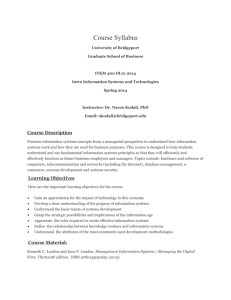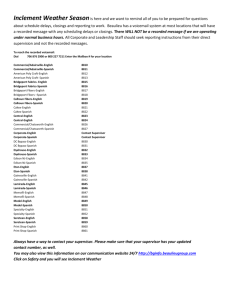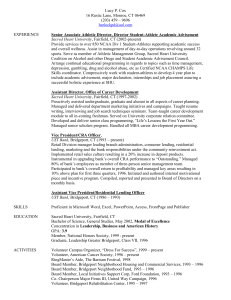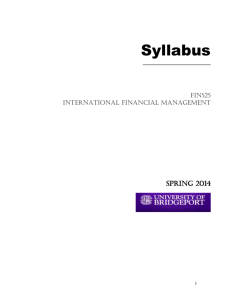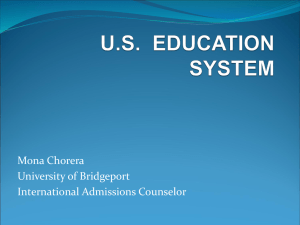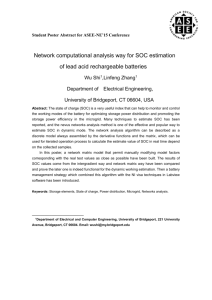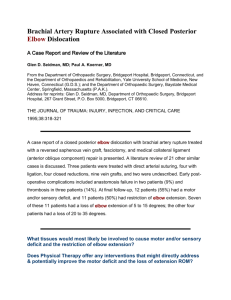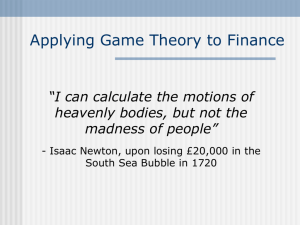University of Bridgeport
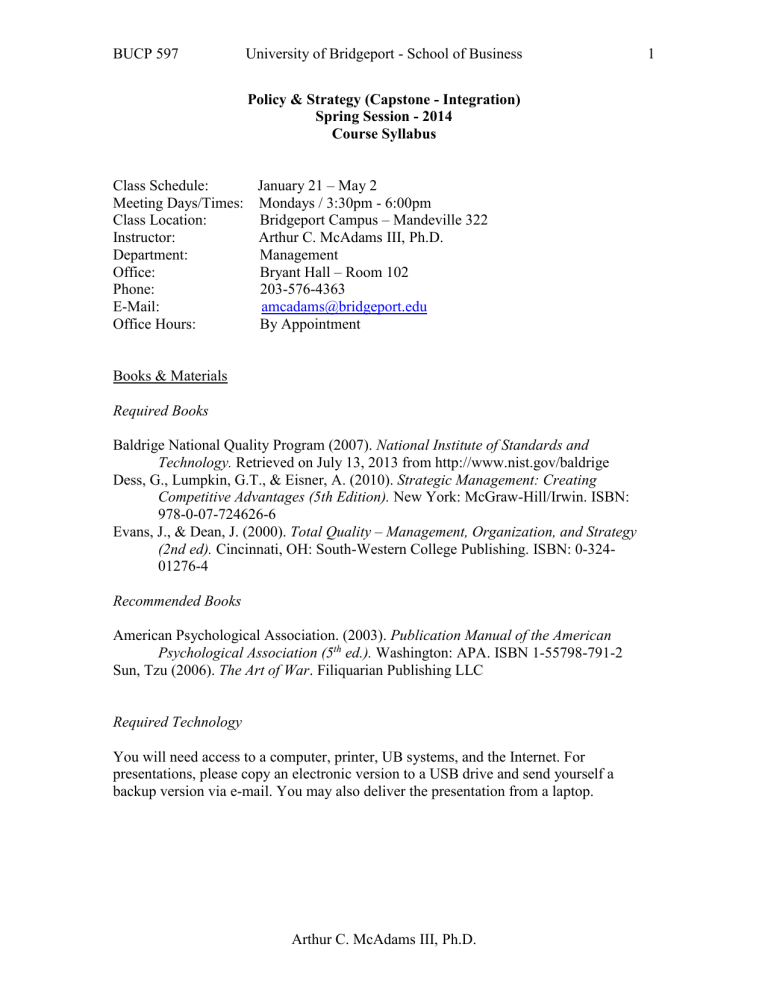
BUCP 597 University of Bridgeport - School of Business
Policy & Strategy (Capstone - Integration)
Spring Session - 2014
Course Syllabus
Class Schedule: January 21 – May 2
Meeting Days/Times: Mondays / 3:30pm - 6:00pm
Class Location: Bridgeport Campus – Mandeville 322
Instructor: Arthur C. McAdams III, Ph.D.
Department: Management
Office: Bryant Hall – Room 102
Phone: 203-576-4363
E-Mail: amcadams@bridgeport.edu
Office Hours: By Appointment
Books & Materials
Required Books
Baldrige National Quality Program (2007). National Institute of Standards and
Technology.
Retrieved on July 13, 2013 from http://www.nist.gov/baldrige
Dess, G., Lumpkin, G.T., & Eisner, A. (2010).
Strategic Management: Creating
Competitive Advantages (5th Edition).
New York: McGraw-Hill/Irwin. ISBN:
978-0-07-724626-6
Evans, J., & Dean, J. (2000). Total Quality – Management, Organization, and Strategy
(2nd ed).
Cincinnati, OH: South-Western College Publishing. ISBN: 0-324-
01276-4
Recommended Books
American Psychological Association. (2003).
Publication Manual of the American
Psychological Association (5 th ed.). Washington: APA. ISBN 1-55798-791-2
Sun, Tzu (2006). The Art of War . Filiquarian Publishing LLC
Required Technology
You will need access to a computer, printer, UB systems, and the Internet. For presentations, please copy an electronic version to a USB drive and send yourself a backup version via e-mail. You may also deliver the presentation from a laptop.
1
Arthur C. McAdams III, Ph.D.
BUCP 597 University of Bridgeport - School of Business 2
Course Description & Approach
As the MBA integration capstone course, Policy & Strategy provides an opportunity for students to apply the knowledge and skills they have learned throughout their studies with their business experiences from a multi-/intra-/inter-disciplinary perspective.
Students will examine the challenges in - and methods for - achieving organizational excellence in the new economy. These lessons will be used to: evaluate an industry, compare two companies within the industry, construct a formal proposal that defines a performance improvement for one of the chosen organizations, and create a personal strategy for post-graduation success.
Learning Outcomes
•
Integrate and apply previously learned academic concepts in accounting, finance, management, marketing, operations, and technology to the real world
• Develop the conceptual knowledge and pragmatic skills to define, design, and deliver ethical, effective, and efficient organizational performance
•
Gain knowledge of strategy frameworks and vocabulary that enable the identification of critical issues, opportunities, and priorities in real situations
• Refine the ability to analyze alternatives, make decisions, summarize difficult concepts, and communicate ideas that drive future actions
•
Understand the importance of global markets, including growth opportunities, sourcing implications, and governance issues
•
Develop the ability to manage dynamic stability
•
Bridge the gap between theory and practice by developing an understanding of why, when, and how to apply relevant concepts and techniques
Course Requirements & Guidelines
This course requires both oral and written assignments. Research is an important component of this class and it allows you the opportunity to integrate your interests with the course theories. You will be required to complete a total of three informal oral reports on current events, three two-page case studies, one 20-page individual industry term paper that includes an informal five-minute presentation, one comprehensive 28-slide performance improvement proposal along with a more concise 12-slide version for presentations, and one five-page reflection paper. All printed work is due at the beginning of class.
An MBA degree is designed to prepare students for a career as a general manager
(executive, CEO, entrepreneur, etc.). With this in mind, please try to think of all assignments as really important business opportunities. Imagine showing up for an important meeting without any preparation, or the proper paperwork, or delivering a presentation that is littered with spelling errors. For this class, please write e-mails with at least semi-professional form and refrain from using slang or any poor writing style.
Arthur C. McAdams III, Ph.D.
BUCP 597 University of Bridgeport - School of Business 3
Each written assignment should be typed and meet the minimum requirement for content and length. All assignments should be printed, stapled, paginated, and include a title, the student’s name and student number, the course name and section, and the type of assignment. All papers should use 12-point font, be double-spaced, and utilize a formal writing style.
Presentations should include a final slide with references and be printed in gray scale that contains six slides per page. Each slide should have a heading. Try to stay consistent
(a.k.a. parallelism) within each slide. In other words, if your first statement is a proper sentence, then keep using sentences for the remainder of the slide and use proper punctuation. If you use bullets and start with verbs, then continue to use verbs for the remainder of the slide. Please use proper punctuation regardless of style.
Please keep in mind that communicating clearly and concisely is a valuable skill in today’s information-based and time-sensitive culture. These skills are also transferable to any discipline and vocation you choose to explore. Speaking proper English was the overriding theme in the 1964 musical My Fair Lady in which Professor Higgins sings;
“this verbal class distinction by now should be antique.” This is not a communication class, and my English is far from perfect, but just as in most office settings, you will be required to write and present your thoughts to multiple audiences. I create these difficult course requirements because I want you to be prepared for post-academic life (I’m really not trying to punish you with random onerous demands!).
Mark Twain once quipped, “I apologize for the length of this letter, if I had had more time it would have been much shorter.” With this in mind, you may want to build a theoretical or conceptual framework for your paper. This is fairly easy and is just for you
- so keep it simple. Write a few sentences for each of the major sections and try to build your paper around these markers. This may help you stay focused on the subject.
Occasionally papers, much like projects, suffer from “scope creep” and take on too many divergent topics. You may want to save the other topics for future papers.
Most students enjoy hearing what other students have researched, which is one of the reasons I will often ask you to share your research with the class. Although public speaking still ranks as one of the most feared things in this world (along with death) it is a required in most vocations, and an academic setting is an ideal stage for building this important skill. When presenting, please do not read the slides verbatim.
Your introduction should be really clear and objective. This is your only chance to gain the audience’s attention. A confusing message or a biased attack will almost always disengage or alienate your audience. Try to paraphrase your points and give the audience some insight into the important points in each slide. Please try to end your presentation by restating the primary problem and then stating your position, which may include your conclusion, a recommendation, a request for approval/funding, etc.
Over the years I have noted a few “areas of opportunity” related to submitted work. First, don’t look past the really easy stuff. Please make sure you use the proper number of
Arthur C. McAdams III, Ph.D.
BUCP 597 University of Bridgeport - School of Business 4 references and satisfy the required length in pages or slides. Don’t forget to run a “spell check” function on your work and check for homophones (e.g. to, too, two). Please follow the framework! I do not want a simple report that restates a collection of data. As future leaders you know there is an information hierarchy: data, information, knowledge, and wisdom. Critical thinking involves reflection and knowledge that reveals insight that builds on established theoretical ideals or offers new revelations. Knowing that the stock market crashed in 1987 is a pretty interesting fact; knowing how to think about the market and any of the possible cause-and-effect relationships that may materialize in the future is much more valuable.
Please be sure to cite all references properly and it is very important that you comply with the University of Bridgeport’s position on academic honesty that may be found in the
University of Bridgeport Student Handbook. “It is the student's responsibility to familiarize himself or herself with and adhere to the standards set forth in the policies on cheating and plagiarism as defined in Chapters 2 and 5 of the Key to UB http://www.bridgeport.edu/pages/2623.asp
or the appropriate graduate program handbook.”
Course Deliverables
1. Class Participation:
Attendance at each class session is expected. A significant portion of your learning will accrue through the constructive and respectful exchange of ideas. Class lectures complement, but do not duplicate, textbook information. Students are expected to be on time and prepared for class. Please turn off and store all unnecessary technology before class.
Please bring a relevant news article to class each week and to be prepared to lead a brief classroom conversation on your chosen topic. Students are also required to write a journal about the class that highlights the student’s thoughts related to the key concepts. These assignments will not be collected.
2. Cases:
All students will complete three two-page written cases.
Each case study should include the following five sections:
Summary - Summarize the key issues and facts of the case
Questions - Answer the questions associated with the case (if the case does not have any questions - then make up three of your own)
Recommendations - Make recommendations based on the facts and your experience
Lessons Learned – List the most valuable lessons you learned from the case
Remaining Questions - Identify one case-related question that you would like to have discussed in class
Arthur C. McAdams III, Ph.D.
BUCP 597 University of Bridgeport - School of Business 5
3. Individual Term Paper – Industry and Company Strategic Audit Review and Analysis:
Each student will thoroughly analyze an industry using Porter’s Five-Forces Model of
Industry Competition, and will then evaluate the performance of two companies in the industry using the Baldrige Performance Excellence Program, The Balanced Scorecard, and a SWOT analysis. The paper should include a thoughtful analysis of the historic, current, and projected performance of the industry and the companies using any frameworks, tools, and concepts from well-known scholars and practitioners as a way to develop recommendations to improve future performance.
At a minimum, the following topics must be covered in the paper:
Industry dynamics – Use Porter’s Five Forces to identify major characteristics and trends impacting the industry; including history, lifecycle phases, industry size, regulations, mergers, acquisitions, joint ventures, use of technology, economics, profitability, competitive landscape, vulnerability to substitution, etc.
Company Analysis – Identify and address major themes and issues by using the criteria from The Baldrige Performance Excellence Program, as well as any related tenets from Quality, and The Balanced Scorecard. Complement this work by performing a SWOT analysis on each company.
Recommendations – Based on your earlier work and with careful analysis on the progression of the industry, company, and product within its respective lifecycle; provide a summary that addresses the major performance issues, constraints, and critical success factors for the industry and both companies.
Questions that should be answered in your paper
What is the industry, why does it exist, and how long has it existed?
Where is it in its lifecycle?
How much emphasis is placed on marketing, operations, and finance?
What does the competitive landscape look like?
Are there segments, and is there an untapped market?
Is there an obsolete function in the industry?
Can technology disrupt the industry?
Where do the two companies fit in the industry’s competitive landscape?
Is the industry ready for rejuvenation?
What problems need solutions?
What would you do if you were the captain of the industry and/or the two companies?
Porter’s Five Forces
1.
Competitive Rivalry within an Industry
2.
Bargaining Power of Suppliers
3.
Bargaining Power of Customers
4.
Threat of New Entrants
5.
Threat of Substitute Products
Arthur C. McAdams III, Ph.D.
BUCP 597 University of Bridgeport - School of Business 6
Baldrige Performance Excellence Program
What is our competitive position, our market, and who are our competitors?
What are the factors that determine our success, and what changes and opportunities do you see in the future?
What are our sources of comparative and competitive data within our industry, and any analogous processes outside our industry?
What are our strategic challenges, including business, operational, human resource, as well as organizational sustainability?
Do we have a performance improvement system that supports an ongoing focus on organizational learning and improvement of processes?
What are our partnering relationships and communication mechanisms with key constituencies?
The Balanced Scorecard
Financial – ROI and Economic Value
Customer – Satisfaction, Retention, Market Awareness
Internal – Quality, Product Introduction Cycle, Efficiency
Learning & Growing – Employee Satisfaction/Knowledge
SWOT: How can the company…
leverage its Strengths? make its Weaknesses irrelevant? exploit its Opportunities in the market? minimize its Threats?
The complete paper should be between 20 and 25 pages. All papers must have a table of contents and cite at least 15 different sources. Each student is required to orally summarize his or her term paper in five minutes using printed PowerPoint slides, index cards, or handwritten notes that will not be collected.
4. Performance Improvement Proposal
The purpose of the plan is to prepare a formal and valuable proposal for one of the companies in the individual industry paper. This will require integrating the major concepts studied throughout this semester, and may include external solution, such as merging, acquiring, divesting, outsourcing, etc. Please keep in mind that this assignment offers you an opportunity to demonstrate your creativity and initiative. I will not “give you an idea” (that is the hard part) and I will not ask you for constant updates.
This assignment requires two deliverables: a comprehensive 28-slide PowerPoint presentation that will serve as the detailed plan and a concise 12-slide version that will serve as the instrument for class presentations. This assignment requires at least 7 sources.
Arthur C. McAdams III, Ph.D.
BUCP 597 University of Bridgeport - School of Business 7
Your proposal should flow something like this (define > design > deliver):
1.
Who are you?
2.
What is your product/service/enhancement?
3.
What problem are you solving?
4.
What does the overall market/situation look like?
5.
What does your target market/situation look like?
6.
What is your competitive position/advantage?
7.
How will the company produce your product and service?
8.
What management/organizational changes will be required?
9.
How much money do you need to start?
10.
How long will it take to break even?
11.
Do you have checkpoints or an exit strategy?
12.
Why should we believe your story?
5. Individual Reflection Paper:
Each student will write a five-page paper that includes an assessment of the value of your
MBA degree, and includes a personal five-year strategic plan that addresses the type of job, industry, company, salary, etc. that you will pursue after graduation. You will also want to include your personal mission, vision, and SWOT analysis. Please keep in mind that this requires a significant amount of critical thinking and will require more than a few hours of work (simply stating that your friends think you are funny and you want to make a lot of money does not satisfy the requirements for this final assignment).
Course Schedule
This course will not be divided into modules, but will roughly align with the three major
“Parts” in the textbook: Strategic Analysis, Formulation, and Implementation. Each
“Part” will be approximately four weeks long. The final week of the course will include review and reflection of all the course material. We may adjust the schedule slightly based on class dynamics, so please take note of deadlines for deliverables – thanks.
Course Grading
Inevitably, the question of grading criteria surfaces sometime during the semester. As you have probably noted, I do not administer easily quantifiable methods for evaluating your knowledge of the concepts in the course. I choose to use reports, presentations, and openended questions in classroom discussion as a way to measure your learning, which are more qualitative. This probably makes it a little harder for both of us, but I believe it is the best way to measure knowledge.
I will use the following rubric and matrix for your papers and presentations:
Argument
H: clear distinction between criteria and a concise persuasive conclusion
L: no distinct choice between criteria: ambiguous framework, “book report”
Arthur C. McAdams III, Ph.D.
BUCP 597 University of Bridgeport - School of Business 8
Compliance
H – all requirements fully met
L – more than two major deficiencies
Creativity
H: new or novel approach/concept to a subject
L: familiar set of ideas and contrasts
Grammar
H: no errors or very few minor errors
L: difficult to interpret content/message
Organization
H: clear outline, symmetrical, and aesthetically acceptable
L: unprofessional, poor construction of content with little use of proper formatting
Any paper that includes any form of plagiarism will be graded “50.” For the first offense, the student will have an opportunity to send me a three-paragraph email that describes the specific plagiarism offense, a comment on the seriousness of academic integrity, and includes a promise from the student that he/she has now read the full description of plagiarism and commits to a plagiarism-free academic experience. The initial “50” will then be revised favorably for the student; though not to exceed “80.” A second offense will result in an “F” for the course and a written comment in the student’s file.
Please keep in mind that your final grade is cumulative so you will not be able to “make up” for missed classes and poor performance during the last week of the semester.
If your attendance and punctuality are nearly perfect, your alertness and attention are proper, your participation is acceptable, and you comply with the guidelines for deliverables, you will probably earn a “B” for the course. I will happily award higher grades for engaged participation and work that exhibits exceptionally rigorous and insightful thinking as described in the rubric.
Grading Breakdown
Class Participation
Case Analyses
Term Paper
Proposal Project
Individual Reflection Paper
25%
5%
25%
25%
20%
100%
Arthur C. McAdams III, Ph.D.
BUCP 597 University of Bridgeport - School of Business 9
Recommended Sources for Reports and Presentations
Burtonshaw-Gunn, S. (2008). The Essential Management Toolbox . West Sussex,
England: John Wiley & Sons Ltd.
Carr, N. (2003, May). IT doesn’t matter.
Harvard Business Review, 81(5), 41-49 .
Christensen, C. (1997). The Innovator’s Dilemma . Boston: Harvard Business School
Press.
Collins, J., & Porras, J. (1994). Built to Last . New York: HarperCollins Publishers Inc.
Cooper, A. (2004). The Inmates are running the Asylum . Indianapolis, IN: Sams
Publishing.
Couger, J. (1996). Creativity & Innovation in Information Systems Organizations .
Danvers MA: Boyd & Fraser Publishing Company.
Davenport, T., & Prusak, L. (2000). Working Knowledge: How Organizations Know
What They Know.
Cambridge, MA: Harvard Business School Press.
Davis, S., & Meyer, C. (1998). Blur.
Reading, MA: Addison-Wesley.
DeMarco, T. (1997). The Deadline: A Novel about Project Management.
New York:
Dorset House Publishing. ISBN 0-932633-39-0
Drucker, P. (2001). The Essential Drucker . New York: HarperCollins Publishers. ISBN
978-0-06-134501-2
Drucker, P. (2002). Managing the Next Society . New York: St. Martin’s Press.
Extreme Chaos. (2001). The Standish Group Report . Retrieved July 4, 2005, from http://www.standishgroup/com/sample_research/PDFpages/extreme_chaos.pdf
Friedman, M. (1962). Capitalism and Freedom .
Friedman, T. (2005). The World is Flat: A Brief History of the Twenty-First Century .
Farrar, Straus, & Giroux.
Gladwell, M. (). Tipping Point or Blink .
Hamel, G., & Prahalad, C. (1994). Competing for the Future.
Boston: Harvard Business
School Press.
Hammer, M., & Champy, J. (2003). Reengineering the Corporation: A Manifesto for
Business Revolution.
New York: HarperCollins Publishers Inc.
Hiltzik, M. (1999). Dealers of Lightening: Xerox PARC and the Dawn of the Information
Age. New York: HarperCollins Publishers Inc.
Holbeche, L. (2005). The High Performance Organization: Creating Dynamic Stability and Sustainable Success.
Boston: Butterworth-Heinemann.
Hunger, D., & Wheelen, T. (1998). Strategic Management . Reading, MA: Addison-
Wesley.
Johnson, S. (1998). Who moved my Cheese? Putnum.
Kaplan, R., & Norton, D. (1996). The Balanced Scorecard . Boston: Harvard Business
School Press.
Kim, W., & Mauborgne, R. (2005). Blue Ocean Strategy: How to Create Uncontested
Market Space and Make Competition Irrelevant.
Boston: Harvard Business
School Publishing Corporation.
Knoke, W. (1996). Bold New World.
New York: Kodansha International.
Lewis, C.S. (1982). The Screwtape Letters . NY: Touchstone.
Lowney, C. (2005). Heroic Leadership
Machiavelli, N (1532). The Prince.
Arthur C. McAdams III, Ph.D.
BUCP 597 University of Bridgeport - School of Business 10
Marx & Engels. (). The Communist Manifesto
May, T. (2004). Using PR to win the information War. Retrieved January 17, 2005, from www.computerworld.com/managementtopics/management/story/0,10801,98002,0
0.html
McElroy, M. (2001). Second-Generation Knowledge Management. Macroinnovation
Associates LLC. Retrieved on January 14, 2004, from www.macroinnovation.com
Orwell, G. (). Animal Farm or 1984.
Palmer, D. (1994). Looking at Philosophy: The Unbearable Heaviness of Philosophy made Lighter (2nd ed.). Mountain View, CA: Mayfield Publishing Company.
Peters, T. (2003). Re-Imagine!
London: Dorling Kindersley Limited.
Plato (380BC). The Republic .
Porter, M. (1998). Competitive Strategy. Free Press.
Senge, P. (1990). The Fifth Discipline: The Art & Science of the Learning Organization .
NY: Doubleday.
Smith, A (1776). The Wealth of Nations .
Sveiby, K. (1997). The New Organizational Wealth . San Francisco, CA: Berrett-Koehler
Publishers Inc.
Swift, J. (). A Modest Proposal .
Teich, A. (2002). Technology and the Future (9th ed.).
Boston: Wadsworth Publishing.
Volti, R. (2001). Society and Technological Change (4th ed.).
New York: Worth
Publishers.
Welch, J. (2001). Straight from the Gut. NY: Warner Books Inc.
Wetherbe, J. (2005). Information Technology for Management: Transforming
Organizations in the Digital Economy . Wiley & Sons Publishing.
Womack, J., & Jones, D. (1996). Lean Thinking: Banish Waste and Create Wealth in
Your Organization.
NY: Simon & Schuster.
Wooden, J., & Carty, J. (2009). Pyramid of Success. Gospel Light Publications.
Wysocki, R., & McGary, R. (2004). Effective Project Management (3rd ed.).
Indianapolis, IN: John Wiley & Sons Inc.
Other Valuable Sources
Business periodicals – Business Week, Forbes, Economist, Fortune, Harvard Business
Review, Newsweek, Sloan Management Review, Wall Street Journal et al.
UB electronic library
You may also use Google and Wikipedia - but be careful!
Arthur C. McAdams III, Ph.D.
